Immobilization of the Amidohydrolase MxcM and Its Application for Biocatalytic Flow Synthesis of Pseudochelin A
Abstract
1. Introduction
2. Results and Discussion
2.1. Immobilization of MxcM
2.1.1. Influence of Divalent Metal Ions
2.1.2. Influence of Enzyme Concentration, Immobilization Time, and Enzyme-to-Particle Ratio
2.1.3. Activity of Immobilized MxcM in Organic Solvents
2.1.4. Storage Stability of the Immobilized MxcM
2.2. Design and Characterization of the Immobilized Enzyme Reactor
2.2.1. Reactor Packing
2.2.2. Residence Time Behavior
2.2.3. Operation in Semicontinuous Mode
3. Materials and Methods
3.1. Production and Purification of Myxochelin B and Pseudochelin A
3.2. Enzyme Production and Purification
3.3. Immobilization
3.4. Activity in Organic Solvents and Storage Stability of Immobilized MxcM
3.5. Reactor Packing
3.6. Characterization of the Residence Time Behavior
3.7. Characterization of the Reactor Performance in Semicontinuous Mode
4. Conclusions
Supplementary Materials
Author Contributions
Funding
Data Availability Statement
Acknowledgments
Conflicts of Interest
References
- Alvarez-Builla, J.; Vaquero, J.J.; Barluenga, J. Modern Heterocyclic Chemistry; Wiley-VCH: Weinheim, Germany, 2011; ISBN 978-3-527-63406-4. [Google Scholar]
- Quin, L.D. Fundamentals of Heterocyclic Chemistry: Importance in Nature and in the Synthesis of Pharmaceuticals; Online-Ausg; John Wiley & Sons, Incorporated: Hoboken, NJ, USA, 2010; ISBN 9780470626535. [Google Scholar]
- Vitaku, E.; Smith, D.T.; Njardarson, J.T. Analysis of the structural diversity, substitution patterns, and frequency of nitrogen heterocycles among U.S. FDA approved pharmaceuticals. J. Med. Chem. 2014, 57, 10257–10274. [Google Scholar] [CrossRef]
- Lamberth, C. Heterocyclic chemistry in crop protection. Pest Manag. Sci. 2013, 69, 1106–1114. [Google Scholar] [CrossRef] [PubMed]
- Nicolaou, K.C.; Rigol, S. A brief history of antibiotics and select advances in their synthesis. J. Antibiot. 2018, 71, 153–184. [Google Scholar] [CrossRef] [PubMed]
- Meanwell, N.A. Synopsis of some recent tactical application of bioisosteres in drug design. J. Med. Chem. 2011, 54, 2529–2591. [Google Scholar] [CrossRef] [PubMed]
- Gomtsyan, A. Heterocycles in drugs and drug discovery. Chem. Heterocycl. Comp. 2012, 48, 7–10. [Google Scholar] [CrossRef]
- Taylor, A.P.; Robinson, R.P.; Fobian, Y.M.; Blakemore, D.C.; Jones, L.H.; Fadeyi, O. Modern advances in heterocyclic chemistry in drug discovery. Org. Biomol. Chem. 2016, 14, 6611–6637. [Google Scholar] [CrossRef]
- Guo, W.; Zhao, M.; Tan, W.; Zheng, L.; Tao, K.; Fan, X. Developments towards synthesis of N-heterocycles from amidines via C–N/C–C bond formation. Org. Chem. Front. 2019, 6, 2120–2141. [Google Scholar] [CrossRef]
- Abdella, A.M.; Abdelmoniem, A.M.; Abdelhamid, I.A.; Elwahy, A.H.M. Synthesis of heterocyclic compounds via Michael and Hantzsch reactions. J. Heterocycl. Chem. 2020, 57, 1476–1523. [Google Scholar] [CrossRef]
- Murlykina, M.V.; Morozova, A.D.; Zviagin, I.M.; Sakhno, Y.I.; Desenko, S.M.; Chebanov, V.A. Aminoazole-Based Diversity-Oriented Synthesis of Heterocycles. Front. Chem. 2018, 6, 527. [Google Scholar] [CrossRef]
- Henary, M.; Kananda, C.; Rotolo, L.; Savino, B.; Owens, E.A.; Cravotto, G. Benefits and applications of microwave-assisted synthesis of nitrogen containing heterocycles in medicinal chemistry. RSC Adv. 2020, 10, 14170–14197. [Google Scholar] [CrossRef]
- Ley, S.V. On being green: Can flow chemistry help? Chem. Rec. 2012, 12, 378–390. [Google Scholar] [CrossRef] [PubMed]
- Newman, S.G.; Jensen, K.F. The role of flow in green chemistry and engineering. Green Chem. 2013, 15, 1456. [Google Scholar] [CrossRef]
- Sharma, U.K.; van der Eycken, E.V. Flow Chemistry for the Synthesis of Heterocycles; Springer International Publishing: Cham, Switzerland, 2018; ISBN 978-3-319-94327-5. [Google Scholar]
- Pastre, J.C.; Browne, D.L.; Ley, S.V. Flow chemistry syntheses of natural products. Chem. Soc. Rev. 2013, 42, 8849–8869. [Google Scholar] [CrossRef] [PubMed]
- Sheldon, R.A.; Brady, D. Streamlining Design, Engineering, and Applications of Enzymes for Sustainable Biocatalysis. ACS Sustain. Chem. Eng. 2021, 9, 8032–8052. [Google Scholar] [CrossRef]
- Pinho e Melo, T.M.; Pineiro, M. Heterocycles: Synthesis, Catalysis, Sustainability, and Characterization; Wiley-VCH: Weinheim, Germany, 2022; ISBN 978-3-527-83200-2. [Google Scholar]
- Lechner, H.; Pressnitz, D.; Kroutil, W. Biocatalysts for the formation of three- to six-membered carbo- and heterocycles. Biotechnol. Adv. 2015, 33, 457–480. [Google Scholar] [CrossRef]
- Diana, P.; Cirrincione, G. Biosynthesis of Heterocycles; John Wiley & Sons, Inc.: Hoboken, NJ, USA, 2015; ISBN 9781118960554. [Google Scholar]
- Hemmerling, F.; Hahn, F. Biosynthesis of oxygen and nitrogen-containing heterocycles in polyketides. Beilstein J. Org. Chem. 2016, 12, 1512–1550. [Google Scholar] [CrossRef]
- Meng, S.; Tang, G.-L.; Pan, H.-X. Enzymatic Formation of Oxygen-Containing Heterocycles in Natural Product Biosynthesis. ChemBioChem 2018, 19, 2002–2022. [Google Scholar] [CrossRef] [PubMed]
- Gao, B.; Yang, B.; Feng, X.; Li, C. Recent advances in the biosynthesis strategies of nitrogen heterocyclic natural products. Nat. Prod. Rep. 2022, 39, 139–162. [Google Scholar] [CrossRef]
- Cano-Prieto, C.; García-Salcedo, R.; Sánchez-Hidalgo, M.; Braña, A.F.; Fiedler, H.-P.; Méndez, C.; Salas, J.A.; Olano, C. Genome Mining of Streptomyces sp. Tü 6176: Characterization of the Nataxazole Biosynthesis Pathway. ChemBioChem 2015, 16, 1461–1473. [Google Scholar] [CrossRef]
- Lv, M.; Zhao, J.; Deng, Z.; Yu, Y. Characterization of the Biosynthetic Gene Cluster for Benzoxazole Antibiotics A33853 Reveals Unusual Assembly Logic. Chem. Biol. 2015, 22, 1313–1324. [Google Scholar] [CrossRef]
- Losada, A.A.; Cano-Prieto, C.; García-Salcedo, R.; Braña, A.F.; Méndez, C.; Salas, J.A.; Olano, C. Caboxamycin biosynthesis pathway and identification of novel benzoxazoles produced by cross-talk in Streptomyces sp. NTK 937. Microb. Biotechnol. 2017, 10, 873–885. [Google Scholar] [CrossRef]
- Song, H.; Rao, C.; Deng, Z.; Yu, Y.; Naismith, J.H. The Biosynthesis of the Benzoxazole in Nataxazole Proceeds via an Unstable Ester and has Synthetic Utility. Angew. Chem. Int. Ed. 2020, 59, 6054–6061. [Google Scholar] [CrossRef] [PubMed]
- Horch, T.; Molloy, E.M.; Bredy, F.; Haensch, V.G.; Scherlach, K.; Dunbar, K.L.; Franke, J.; Hertweck, C. Alternative Benzoxazole Assembly Discovered in Anaerobic Bacteria Provides Access to Privileged Heterocyclic Scaffold. Angew. Chem. Int. Ed. 2022, 61, e202205409. [Google Scholar] [CrossRef]
- Korp, J.; Winand, L.; Sester, A.; Nett, M. Engineering Pseudochelin Production in Myxococcus xanthus. Appl. Environ. Microbiol. 2018, 84, e01789-18. [Google Scholar] [CrossRef]
- Sester, A.; Winand, L.; Pace, S.; Hiller, W.; Werz, O.; Nett, M. Myxochelin- and Pseudochelin-Derived Lipoxygenase Inhibitors from a Genetically Engineered Myxococcus xanthus Strain. J. Nat. Prod. 2019, 82, 2544–2549. [Google Scholar] [CrossRef]
- Winand, L.; Vollmann, D.J.; Hentschel, J.; Nett, M. Characterization of a Solvent-Tolerant Amidohydrolase Involved in Natural Product Heterocycle Formation. Catalysts 2021, 11, 892. [Google Scholar] [CrossRef]
- Kuo, W.-H.K.; Chase, H.A. Exploiting the interactions between poly-histidine fusion tags and immobilized metal ions. Biotechnol. Lett. 2011, 33, 1075–1084. [Google Scholar] [CrossRef] [PubMed]
- Ley, C.; Holtmann, D.; Mangold, K.-M.; Schrader, J. Immobilization of histidine-tagged proteins on electrodes. Colloids Surf. B Biointerfaces 2011, 88, 539–551. [Google Scholar] [CrossRef] [PubMed]
- Basso, A.; Brown, M.S.; Cruz-Izquierdo, A.; Martinez, C.A.; Serban, S. Optimization of Metal Affinity Ketoreductase Immobilization for Application in Batch and Flow Processes. Org. Process Res. Dev. 2022, 26, 2075–2084. [Google Scholar] [CrossRef]
- Ueda, E.; Gout, P.; Morganti, L. Current and prospective applications of metal ion–protein binding. J. Chromatogr. A 2003, 988, 1–23. [Google Scholar] [CrossRef]
- Janson, J.-C. Protein Purification: Principles, High Resolution Methods, and Applications; John Wiley & Sons, Incorporated: Hoboken, NJ, USA, 2011; ISBN 9780470940075. [Google Scholar]
- Sugrue, E.; Fraser, N.J.; Hopkins, D.H.; Carr, P.D.; Khurana, J.L.; Oakeshott, J.G.; Scott, C.; Jackson, C.J. Evolutionary expansion of the amidohydrolase superfamily in bacteria in response to the synthetic compounds molinate and diuron. Appl. Environ. Microbiol. 2015, 81, 2612–2624. [Google Scholar] [CrossRef] [PubMed]
- Muszyńska, G.; Zhao, Y.-J.; Porath, J. Carboxypeptidase a: A model for studying the interaction of proteins with immobilized metal ions. J. Inorg. Biochem. 1986, 26, 127–135. [Google Scholar] [CrossRef]
- Zaak, H.; Siar, E.-H.; Kornecki, J.F.; Fernandez-Lopez, L.; Pedrero, S.G.; Virgen-Ortíz, J.J.; Fernandez-Lafuente, R. Effect of immobilization rate and enzyme crowding on enzyme stability under different conditions. The case of lipase from Thermomyces lanuginosus immobilized on octyl agarose beads. Process Biochem. 2017, 56, 117–123. [Google Scholar] [CrossRef]
- Arana-Peña, S.; Rios, N.S.; Carballares, D.; Mendez-Sanchez, C.; Lokha, Y.; Gonçalves, L.R.B.; Fernandez-Lafuente, R. Effects of Enzyme Loading and Immobilization Conditions on the Catalytic Features of Lipase From Pseudomonas fluorescens Immobilized on Octyl-Agarose Beads. Front. Bioeng. Biotechnol. 2020, 8, 36. [Google Scholar] [CrossRef] [PubMed]
- Sheldon, R.A.; Woodley, J.M. Role of Biocatalysis in Sustainable Chemistry. Chem. Rev. 2018, 118, 801–838. [Google Scholar] [CrossRef]
- Laane, C.; Boeren, S.; Vos, K.; Veeger, C. Rules for optimization of biocatalysis in organic solvents. Biotechnol. Bioeng. 1987, 30, 81–87. [Google Scholar] [CrossRef]
- Klibanov, A.M. Improving enzymes by using them in organic solvents. Nature 2001, 409, 241–246. [Google Scholar] [CrossRef] [PubMed]
- Villela Filho, M.; Stillger, T.; Müller, M.; Liese, A.; Wandrey, C. Is log P a Convenient Criterion to Guide the Choice of Solvents for Biphasic Enzymatic Reactions? Angew. Chem. Int. Ed. 2003, 42, 2993–2996. [Google Scholar] [CrossRef]
- Takahashi, H.; Li, B.; Sasaki, T.; Miyazaki, C.; Kajino, T.; Inagaki, S. Immobilized enzymes in ordered mesoporous silica materials and improvement of their stability and catalytic activity in an organic solvent. Microporous Mesoporous Mater. 2001, 44–45, 755–762. [Google Scholar] [CrossRef]
- Stepankova, V.; Bidmanova, S.; Koudelakova, T.; Prokop, Z.; Chaloupkova, R.; Damborsky, J. Strategies for Stabilization of Enzymes in Organic Solvents. ACS Catal. 2013, 3, 2823–2836. [Google Scholar] [CrossRef]
- Li, Q.; Fan, F.; Wang, Y.; Feng, W.; Ji, P. Enzyme Immobilization on Carboxyl-Functionalized Graphene Oxide for Catalysis in Organic Solvent. Ind. Eng. Chem. Res. 2013, 52, 6343–6348. [Google Scholar] [CrossRef]
- Lousa, D.; Baptista, A.M.; Soares, C.M. A molecular perspective on nonaqueous biocatalysis: Contributions from simulation studies. Phys. Chem. Chem. Phys. 2013, 15, 13723–13736. [Google Scholar] [CrossRef] [PubMed]
- Wang, S.; Meng, X.; Zhou, H.; Liu, Y.; Secundo, F.; Liu, Y. Enzyme Stability and Activity in Non-Aqueous Reaction Systems: A Mini Review. Catalysts 2016, 6, 32. [Google Scholar] [CrossRef]
- Hanefeld, U.; Gardossi, L.; Magner, E. Understanding enzyme immobilisation. Chem. Soc. Rev. 2009, 38, 453–468. [Google Scholar] [CrossRef] [PubMed]
- Martin, L.d.; Ebert, C.; Garau, G.; Gardossi, L.; Linda, P. Penicillin G amidase in low-water media: Immobilisation and control of water activity by means of celite rods. J. Mol. Catal. B Enzym. 1999, 6, 437–445. [Google Scholar] [CrossRef]
- Basso, A.; Martin, L.d.; Ebert, C.; Gardossi, L.; Linda, P. High isolated yields in thermodynamically controlled peptide synthesis in toluene catalysed by thermolysin adsorbed on Celite R-640. Chem. Commun. 2000, 6, 467–468. [Google Scholar] [CrossRef]
- Conway, J.; Sloane, N.J.A. Sphere Packings, Lattices and Groups, 3rd ed.; Softcover Version of Original Hardcover Edition 1999; Springer: New York, NY, USA, 2010; ISBN 978-1-4419-3134-4. [Google Scholar]
- Bommarius, A.S.; Riebel, B. Biocatalysis: Fundamentals and Applications; Wiley-VCH: Weinheim, Germany, 2002; ISBN 3-527-30344-8. [Google Scholar]
- Liese, A.; Seelbach, K.; Wandrey, C. Industrial Biotransformations, 2nd completely rev. and extended ed.; Wiley-VCH: Weinheim, Germany, 2010; ISBN 3-527-31001-0. [Google Scholar]
- Cheung, R.C.F.; Wong, J.H.; Ng, T.B. Immobilized metal ion affinity chromatography: A review on its applications. Appl. Microbiol. Biotechnol. 2012, 96, 1411–1420. [Google Scholar] [CrossRef] [PubMed]
- Dachuri, V.; Boyineni, J.; Choi, S.; Chung, H.-S.; Jang, S.-H.; Lee, C. Organic solvent-tolerant, cold-adapted lipases PML and LipS exhibit increased conformational flexibility in polar organic solvents. J. Mol. Catal. B Enzym. 2016, 131, 73–78. [Google Scholar] [CrossRef]
- Li, C.; Tan, T.; Zhang, H.; Feng, W. Analysis of the conformational stability and activity of Candida antarctica lipase B in organic solvents: Insight from molecular dynamics and quantum mechanics/simulations. J. Biol. Chem. 2010, 285, 28434–28441. [Google Scholar] [CrossRef]
- Sharma, S.; Agarwal, G.P. Comparative Studies on the Metal Sorption Characteristics of Chelating Gels for Immobilized Metal Ion Affinity Chromatography. Sep. Sci. Technol. 2002, 37, 3491–3511. [Google Scholar] [CrossRef]
- Tamborini, L.; Previtali, C.; Annunziata, F.; Bavaro, T.; Terreni, M.; Calleri, E.; Rinaldi, F.; Pinto, A.; Speranza, G.; Ubiali, D.; et al. An Enzymatic Flow-Based Preparative Route to Vidarabine. Molecules 2020, 25, 1223. [Google Scholar] [CrossRef] [PubMed]
- Böhmer, W.; Knaus, T.; Volkov, A.; Slot, T.K.; Shiju, N.R.; Engelmark Cassimjee, K.; Mutti, F.G. Highly efficient production of chiral amines in batch and continuous flow by immobilized ω-transaminases on controlled porosity glass metal-ion affinity carrier. J. Biotechnol. 2019, 291, 52–60. [Google Scholar] [CrossRef] [PubMed]
- Lin, Y.-C.; Liang, M.-R.; Lin, Y.-C.; Chen, C.-T. Specifically and Reversibly Immobilizing Proteins/Enzymes to Nitriolotriacetic-Acid-Modified Mesoporous Silicas through Histidine Tags for Purification or Catalysis. Chem. Eur. J. 2011, 17, 13059–13067. [Google Scholar] [CrossRef]
- Bohnet, M. Mechanische Verfahrenstechnik; Wiley-VCH Verlag GmbH: Weinheim, Germany, 2003; ISBN 9783527663569. [Google Scholar]
- McCabe, W.L.; Smith, J.C.; Harriott, P. Unit Operations of Chemical Engineering, 5th ed.; McGraw-Hill: New York, NY, USA, 1993; ISBN 0071127380. [Google Scholar]
- Bornscheuer, U.T.; Huisman, G.W.; Kazlauskas, R.J.; Lutz, S.; Moore, J.C.; Robins, K. Engineering the third wave of biocatalysis. Nature 2012, 485, 185–194. [Google Scholar] [CrossRef]
- Rosenthal, K.; Lütz, S. Recent developments and challenges of biocatalytic processes in the pharmaceutical industry. Curr. Opin. Green Sustain. Chem. 2018, 11, 58–64. [Google Scholar] [CrossRef]
- Schwarz, J.; Rosenthal, K.; Snajdrova, R.; Kittelmann, M.; Lütz, S. The Development of Biocatalysis as a Tool for Drug Discovery. Chimia (Aarau) 2020, 74, 368–377. [Google Scholar] [CrossRef] [PubMed]
- Kinner, A.; Nerke, P.; Siedentop, R.; Steinmetz, T.; Classen, T.; Rosenthal, K.; Nett, M.; Pietruszka, J.; Lütz, S. Recent Advances in Biocatalysis for Drug Synthesis. Biomedicines 2022, 10, 964. [Google Scholar] [CrossRef] [PubMed]

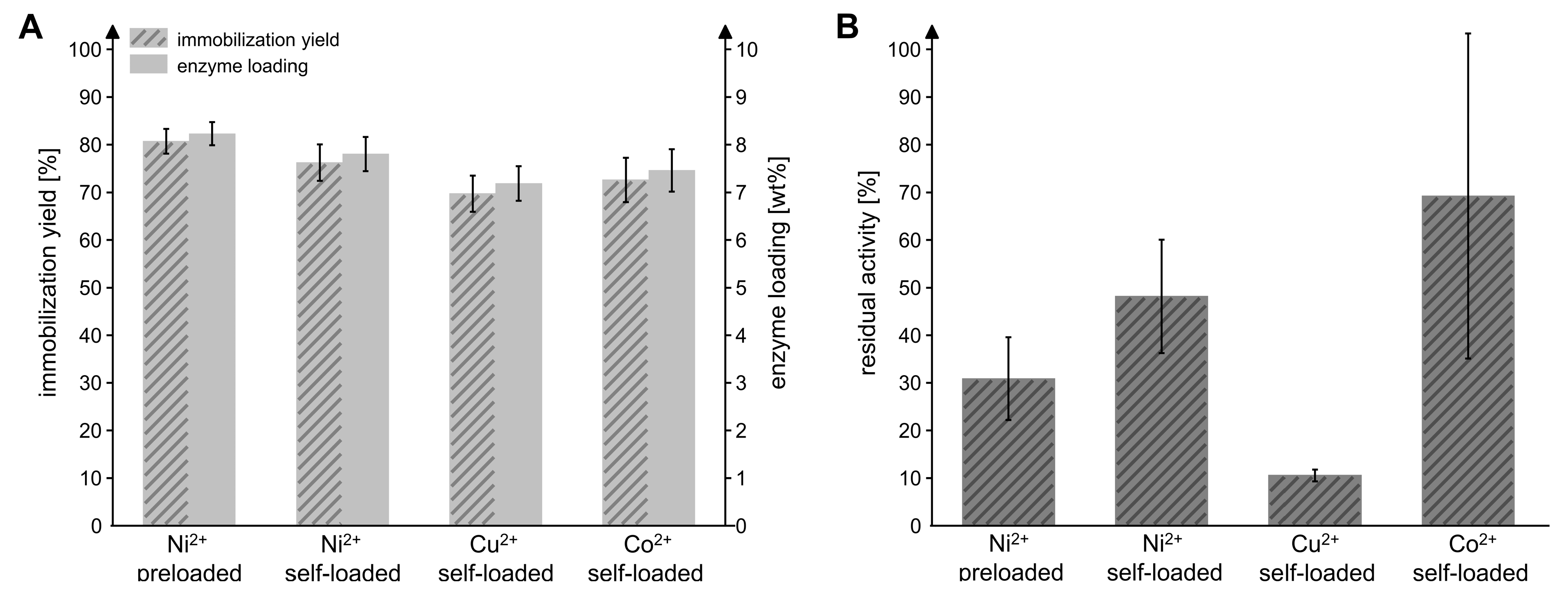
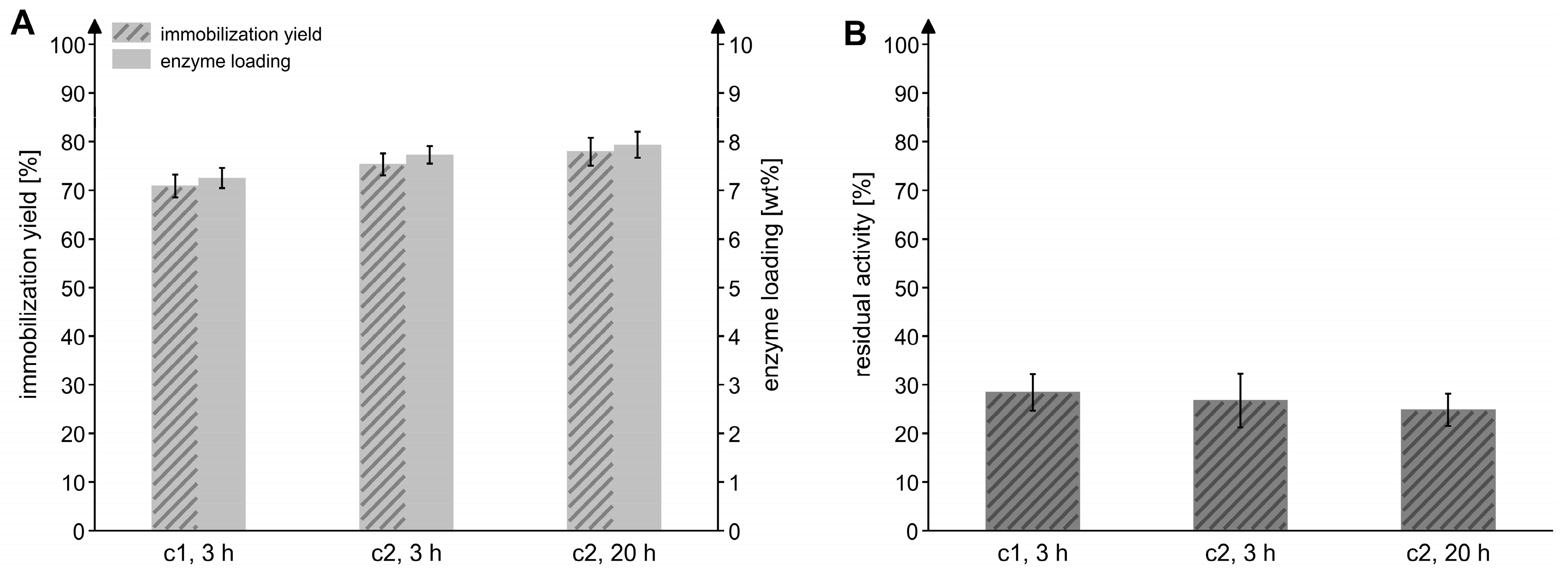
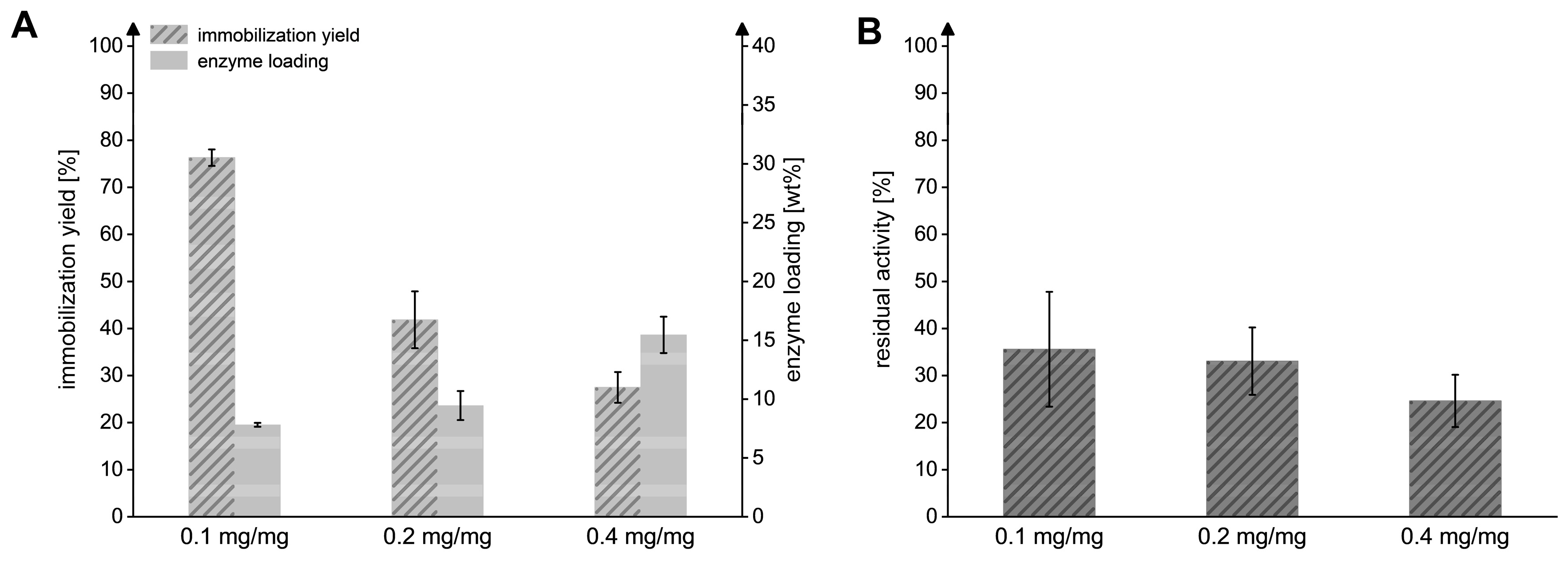
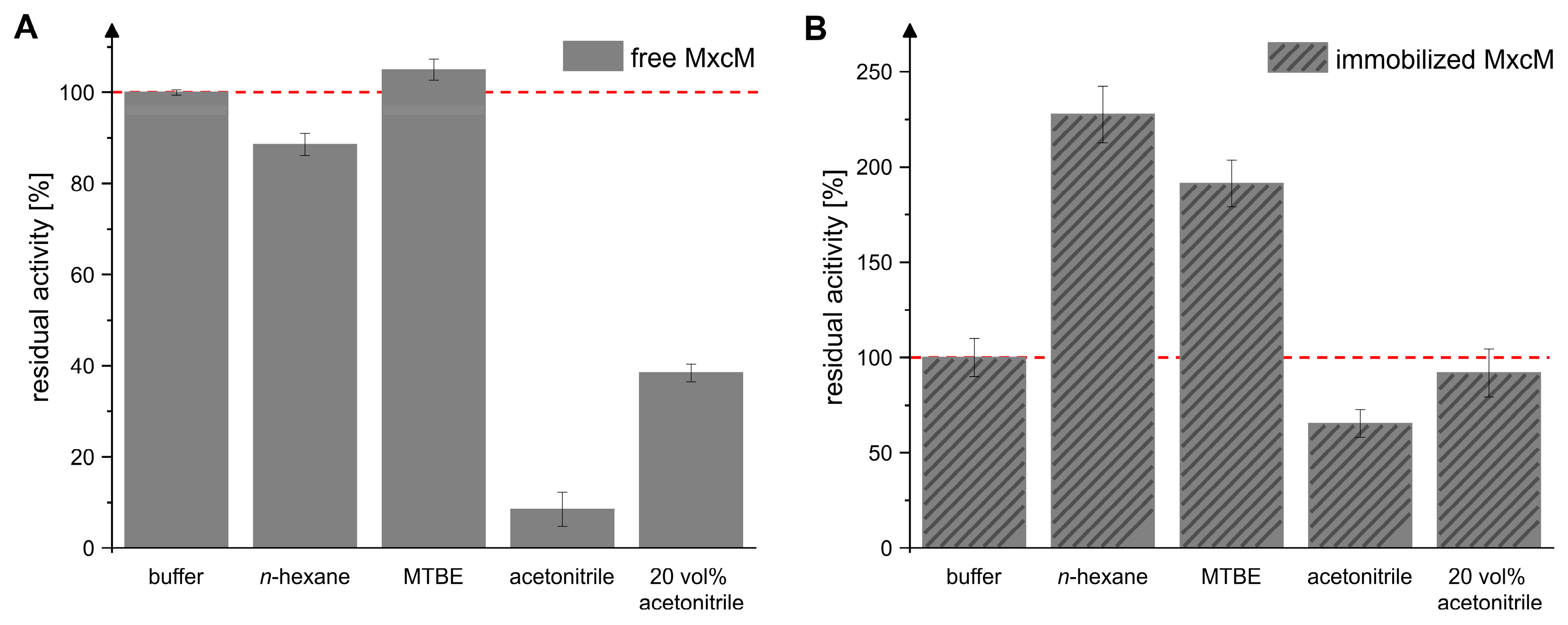
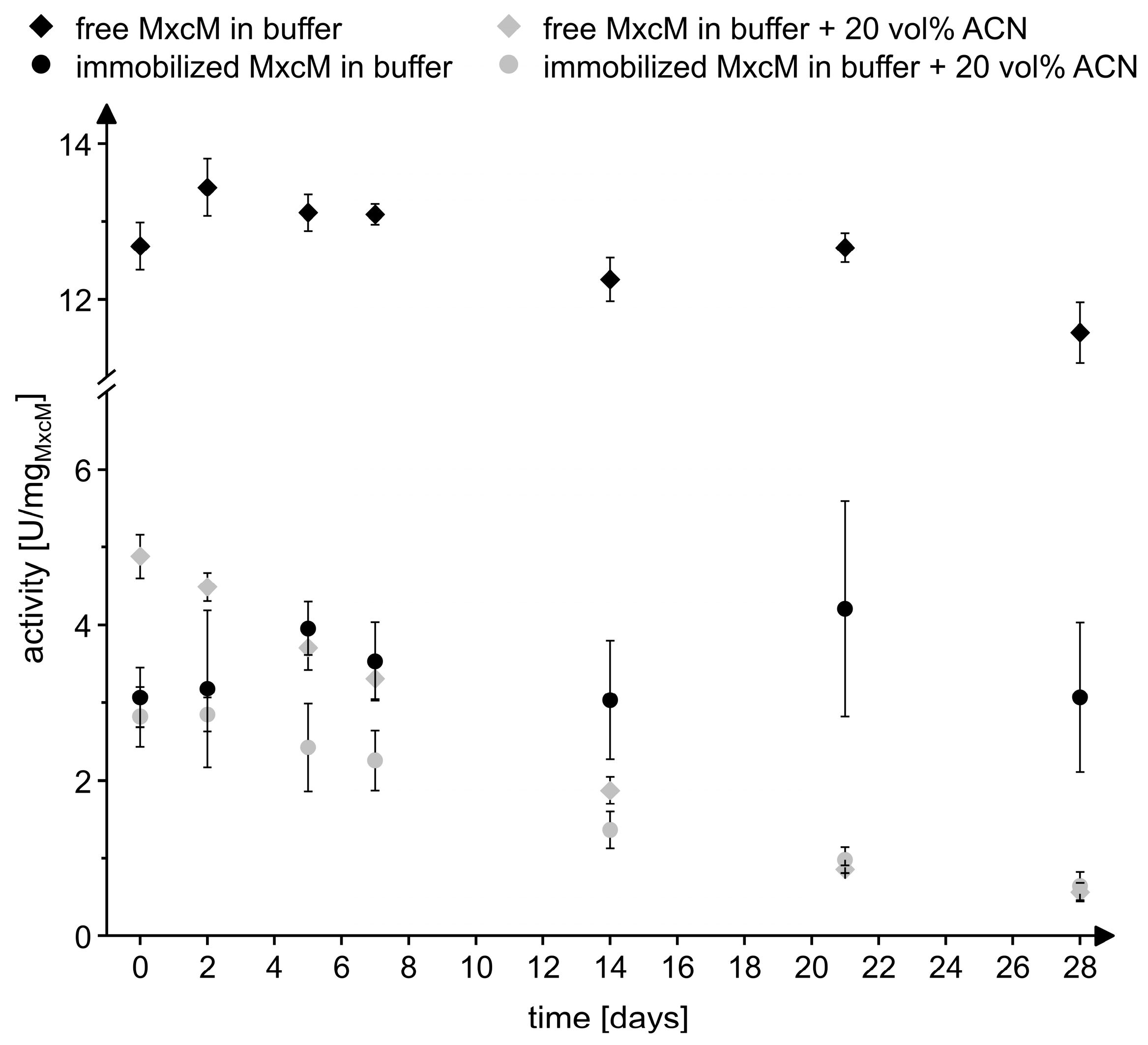


| Parameter | Reactor 1 | Reactor 2 |
|---|---|---|
| Immobilization yield [%] | 87.4 ± 1.1 | 85.6 ± 0.8 |
| Enzyme loading [wt%] | 8.9 ± 0.1 | 8.7 ± 0.1 |
| Particle dry weight [mg] | 29.9 | 29.3 |
| Enzyme mass [mg] | 2.9 | 2.8 |
| Enzyme concentration [mM] | 0.29 | 0.28 |
| Pressure drop at 1.5 mL/min [bar] | 4.1 | 3.8 |
| Theoretical porosity ε [%] 1 | 19.2 | 19.6 |
| Volumetric Flow Rate | Buffer | Buffer + 15 vol% ACN | ||
|---|---|---|---|---|
| Reactor 1 | Reactor 2 | Reactor 1 | Reactor 2 | |
| 0.25 mL/min | 25.4 ± 9.5% | 36.4 ± 0.4% | 96.6 ± 1.1% | 93.5 ± 0.7% |
| 0.50 mL/min | 34.4 ± 4.1% | 42.6 ± 7.2% | 95.7 ± 0.7% | 95.3 ± 0.03% |
| 0.75 mL/min | 41.2 ± 3.1% | 47.8 ± 5.0% | 94.6 ± 2.5% | 93.3 ± 0.3% |
| 1.00 mL/min | 27.5 ± 1.1% | 36.5 ± 6.1% | 94.6 ± 0.5% | 90.3 ± 0.4% |
| Volumetric Flow Rate | Temperature | Buffer | Buffer + 15 vol% ACN | ||
|---|---|---|---|---|---|
| Reactor 1 | Reactor 2 | Reactor 1 | Reactor 2 | ||
| 0.50 mL/min | 30 °C | 58.7 ± 1.4% | 52.4 ± 4.9% | 95.8 ± 1.6% | 91.8 ± 1.0% |
| 50 °C | 49.9 ± 2.0% | 40.8 ± 1.1% | 44.1 ± 1.3% | 52.2 ± 4.1% | |
| 0.75 mL/min | 30 °C | 62.7 ± 0.6% | 44.1 ± 8.1% | 97.0 ± 0.5% | 91.7 ± 0.8% |
| 50 °C | 50.3 ± 2.6% | 41.2 ± 4.2% | 85.1 ± 3.6% | 84.8 ± 3.5% | |
Disclaimer/Publisher’s Note: The statements, opinions and data contained in all publications are solely those of the individual author(s) and contributor(s) and not of MDPI and/or the editor(s). MDPI and/or the editor(s) disclaim responsibility for any injury to people or property resulting from any ideas, methods, instructions or products referred to in the content. |
© 2023 by the authors. Licensee MDPI, Basel, Switzerland. This article is an open access article distributed under the terms and conditions of the Creative Commons Attribution (CC BY) license (https://creativecommons.org/licenses/by/4.0/).
Share and Cite
Winand, L.; Theisen, S.; Lütz, S.; Rosenthal, K.; Nett, M. Immobilization of the Amidohydrolase MxcM and Its Application for Biocatalytic Flow Synthesis of Pseudochelin A. Catalysts 2023, 13, 229. https://doi.org/10.3390/catal13020229
Winand L, Theisen S, Lütz S, Rosenthal K, Nett M. Immobilization of the Amidohydrolase MxcM and Its Application for Biocatalytic Flow Synthesis of Pseudochelin A. Catalysts. 2023; 13(2):229. https://doi.org/10.3390/catal13020229
Chicago/Turabian StyleWinand, Lea, Stefanie Theisen, Stephan Lütz, Katrin Rosenthal, and Markus Nett. 2023. "Immobilization of the Amidohydrolase MxcM and Its Application for Biocatalytic Flow Synthesis of Pseudochelin A" Catalysts 13, no. 2: 229. https://doi.org/10.3390/catal13020229
APA StyleWinand, L., Theisen, S., Lütz, S., Rosenthal, K., & Nett, M. (2023). Immobilization of the Amidohydrolase MxcM and Its Application for Biocatalytic Flow Synthesis of Pseudochelin A. Catalysts, 13(2), 229. https://doi.org/10.3390/catal13020229








